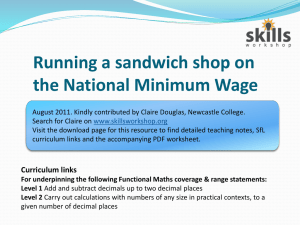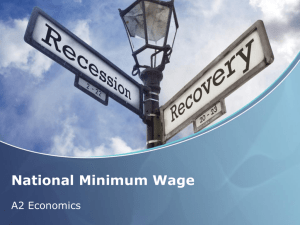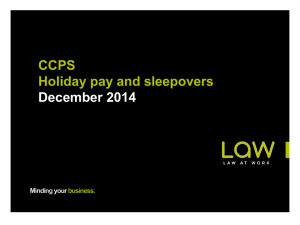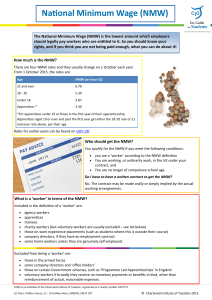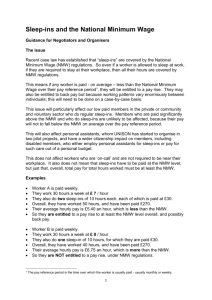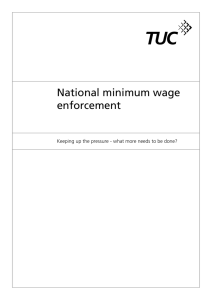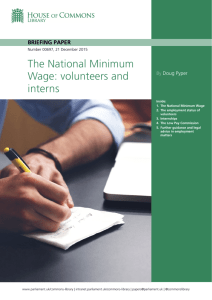Here - British Hospitality Association
advertisement
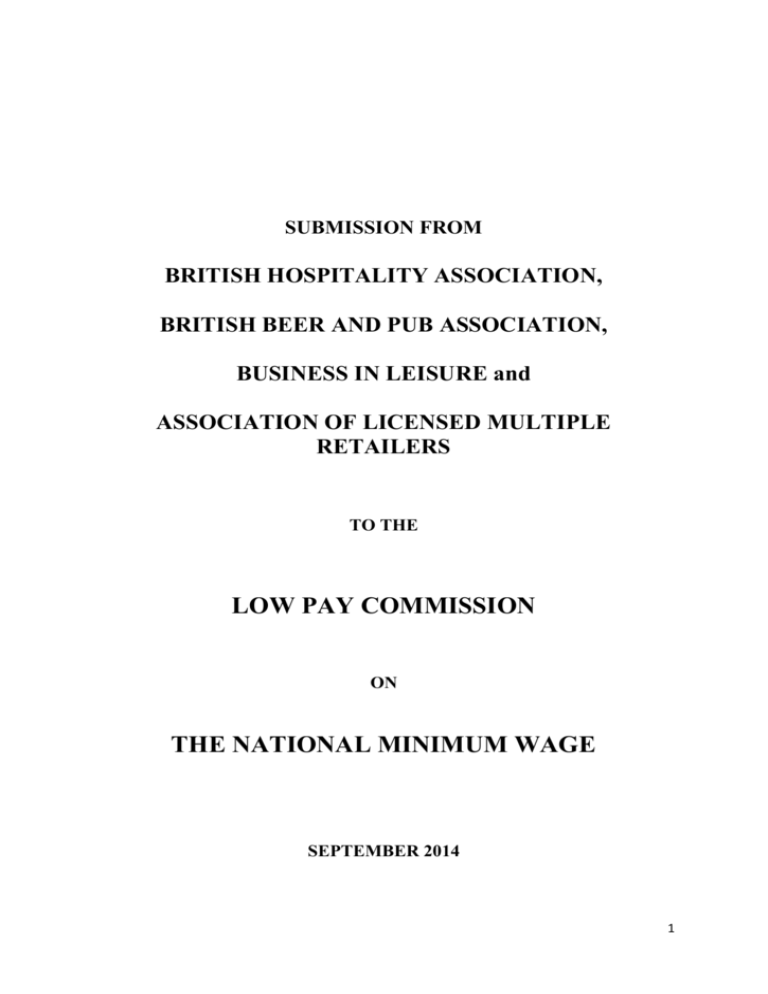
SUBMISSION FROM BRITISH HOSPITALITY ASSOCIATION, BRITISH BEER AND PUB ASSOCIATION, BUSINESS IN LEISURE and ASSOCIATION OF LICENSED MULTIPLE RETAILERS TO THE LOW PAY COMMISSION ON THE NATIONAL MINIMUM WAGE SEPTEMBER 2014 1 Introduction 1. Our four associations (the British Hospitality Association, the British Beer and Pub Association, Business in Leisure, and the Association of Licensed Multiple Retailers) have, between them, made a number of submissions to the Commission over the past 17 years, including annual written and oral evidence and additional written submissions on the accommodation offset (1999), in 2003 and 2005 on whether increases already recommended (for 2004 and 2006 respectively) should proceed, and, in 2009, on the proposal that apprentices’ pay should be brought into the NMW framework. 2. The hospitality and leisure industry has started to recover from the challenging economic situation of the past five years, with turnover and employment levels rising, but, while the hotel and restaurant, and sport and leisure sectors are improving, pubs and nightclubs are still suffering from closures. 3. We now turn to the specific questions asked by the Commission. What are your views on the outlook for the UK economy, including employment and unemployment levels, from now through to September 2016? 4. In broad terms, members of our associations are slightly more optimistic about growth prospects for the next two years than they were in 2013 or 2012. The GDP growth forecasts for 2014 and 2015 and continuing falls in unemployment are encouraging. 5. As we said in our submission a year ago, for our businesses, three factors affect business prospects: disposable income affecting leisure spending; the strength of the corporate sector and inbound tourism. Over the last year, leisure spending has been recovering, corporate spend is returning (though not everywhere) and inbound tourism numbers have performed strongly. In the year to June 2014, both the number of visitors and total spend were up by 7-8% on the previous year. The ONS data, released in August 2014, indicated that the number of jobs in hospitality (accommodation and food and beverage service) were up by 117,000 in the 12 months to March 2014. However, members report a clear tightening of the labour market in terms of availability of people with the necessary skills – chefs (as usual) and reception staff (not as usual) – being in short supply. 6. None of this enables us to take a clear view about the next two years. We are concerned at the impact on disposable income of the next phase of fiscal consolidation (whatever government is formed in May 2015) and by the much anticipated increase in interest rates. Britain’s level of personal indebtedness is very high in comparison to other countries. Even allowing for the fact that many mortgage holders have switched to a fixed rate, the clear consensus amongst forecasters is that even modest rate rises will hit consumer spending. It is our businesses which are particularly susceptible to falls in disposable income. 2 7. The Governor of the Bank of England has been looking at real wages. Understandably, the Bank would prefer to see real wages rising before interest rates are increased. Our member companies are concerned at being required to increase wages in real terms (for a significant proportion of the workforce) at the same time as being confronted with a fall in consumer spending. Increases in interest rates are likely to remove more consumer spending than any increase in general wage levels would introduce. What has been your experience of wage growth in the UK during the last year and what do you forecast for the next twelve to eighteen months? 8. It has been one of the great surprises that wages have not responded to improving employment and growth prospects. The rise in weekly earnings between March and May 2014 of 0.3% and the Bank of England projection that earnings will rise by just 1.25% through 2014 do not fit with what one would expect at this stage of the economic cycle. Clearly, the 2014 increases in the NMW are very much above this level. What has been the impact of the National Minimum Wage (NMW), (for example, on employment, hours and profits), in particular over the last twelve months? Has this impact varied (for example, by sector, type and size of business or groups of workers (including women, ethnic minorities, migrant workers, disabled people, older workers, and those who are unqualified)), and if so how? 9. Over the past year, the NMW has risen by 1.9% for adults and 1% for youth and apprentice groups. This moderate set of increases reflected also our industry’s concern not to choke off employment growth. This does not mean that no employer had to cut back on total employee hours: individual operations in all parts of the industry have run into difficulties even though the general position has been positive. Nevertheless, it would be hard to say that these moderate increases to the NMW had an adverse effect on employment in the past year. What do you estimate will be the impact of the 3% increase in the adult rate of the NMW and 2% increase in the youth and apprentice rates in October 2014? 10. As indicated above, the arithmetical impact on wage costs, assuming the preservation of differentials, should be over 2.5%. As wage costs tend to be around 30%+ in hotels and up to 40% in the larger restaurant/food service sector of the industry, the 2014 increases would be expected, on their own, to add approaching 1% to total industry costs. Given the high price sensitivity in many markets presently, our members’ view was that this increase was at the top level of what could be afforded without damaging side effects on employment levels. In our 2014 Report, we made an additional assessment of the future path of the NMW. This looked at what economic and business conditions needed to be in place to allow a faster increase in the minimum wage rates taking into account the implications on employment. Do you have any comments on that assessment? What economic and business conditions do you think need to be in place for faster increases in the NMW? 3 11. In our evidence to the Commission in 2013, we answered this question by proposing three tests summarised in the Commission’s report as: ‘there had to be a clear and stable trend in the economy over at least a year; there had to be confidence about economic circumstances two years ahead; and job-creation in the low paying sectors attributable to increased business activity’. We were interested to see that the Commission’s own response was not dissimilar. The Commission indicated in its 2014 Report that ‘2014 will mark the start of a new, fourth phase of bigger increases than in recent years in [our] work’. This implies increases in 2015 not only above the average in the recession years but significantly above current wage growth across the economy. This has caused nervousness among our member companies. 12. The implications for employment are obvious and, potentially, significant. As we have mentioned earlier, the increase to the total cost base of our businesses by the October 2014 increases to the NMW, is about one percent. We are concerned at the erosion of margins and profitability that could, in the next two years, very easily result from the combination of rising costs and falling revenues. As mentioned earlier, real wages have not been rising in the economy so to compel businesses to award above inflation increases in wages to a significant proportion of our workforce is a clear risk to employment. What has been the impact of the minimum wage on young people and what effect do you think it has on their employment prospects? 13. We believe that the Commission’s approach to young people has been the right one, in line with our suggestion in our evidence in 2013 that there should be a continued cautious approach to the Development Rate, as this had been the key to job creation for young people. As a major employer of young people, with 31 per cent of our workforce being aged 16 to 24, the industry has also, as noted above, been a major contributor to employment growth to young people in recent years. The Big Hospitality Conversation, with pledges so far of over 35,000 jobs, apprenticeships and work placements for young people, is an example of the industry being proactive. 14. We think the unlocking of increases in the Development Rate from those in the Adult Rate since 2010 has been helpful. From 2009 to 2014, the Development Rate will have risen by 6.2 per cent against 12.0 per cent for the Adult Rate. 15. We were concerned by the Commission’s 2014 Report (section on future increases), which stated (para. 124): “The general conditions necessary for us to recommend faster rises in the adult rate in future also apply to the youth and apprentice rates. However the greater sensitivity of young people’s employment to the economic cycle means we would expect to be able to recommend larger increases for young people when economic conditions have eased.” 4 16. And, in para. 29 of its main Report in 2014, the Commission stated: “… the employment position of young people does now appear to have stabilised. The lower increases in the youth rates that we have recommended in recent years may have played some part in this. … We continue to believe that the youth rates should increase by more than the adult rates when economic circumstances permit.” 17. We would anticipate a risk to youth employment from this approach. Youth unemployment levels are still extremely high. It would be less risky to rely on the trend, noted in the 2014 Report, for some employers to be reverting towards the Adult Rate for those under (or, at any rate, close to) 21, rather than risk the recovery in youth unemployment. The jobs of under 21s who are going to move to the Adult Rate anyway and for whom earnings levels are less important than for older workers would be better protected by a Youth Rate rising at moderate levels, rather than by a big jump ‘catch up’ to reverse the trend of the past five years. 18. We note the ending in April 2015 of employer’s National Insurance Contributions for under 21s. This will help with youth employment, but not if the saving is hypothecated to lifting the Youth Rate. What has been the impact of the Apprentice Rate on pay, provision, take up and completion? 19. When the Apprentice Rate was introduced in 2011, we expressed some surprise at its level, at least for our own sector, given that apprentices in hospitality are likely in many cases to be doing identical on-the-job work to fellow workers on the traditional minimum wage rates. However, the arrival of the Apprentice Rate has created flexibility in starting rates and encouraged employers, especially in the pub trade, to offer apprenticeships to starters. The inclusion of hospitality apprentices in England in the Trailblazers’ scheme will have a beneficial impact on quality of apprenticeship schemes. 20. The Apprentice Rate is most likely to have reduced hourly pay but the greater provision has been reflected in greater take up, especially by young people- we have not seen the emergence of the 35 year old apprentice, as has happened in some sectors. There has also been an improvement in completion levels, with achievements in hospitality and catering (in England) improving by 20 per cent against a 17 per cent rise in starts in 2011/12 against a year earlier. A survey in 2012 by the Sector Skills Council, People 1st, listed barriers to employing apprentices: under 20 per cent of responding employers listed “not economically viable” which might reasonably be assumed to include wage costs for apprentices. Do you think the structure of the Apprentice Rate should change? Could it be made simpler to help improve compliance? Do you think the Apprentice Rate should apply to all levels of apprenticeships? 5 21. First, it is worth noting that apprenticeship arrangements in England are to change significantly over the next three years with greater emphasis on employer involvement, but, at present, uncertainty over funding. There have been concerns that, for hospitality, there may be a resulting reduction in apprenticeship starts. 22. Second, the structure of the Apprentice Rate is rather complicated, compared with the simplicity of the purely age related rates, being a mixture of time served and age related. Intuitively, this seems likely to cause some compliance problems, but maybe no more than those arising when an employee reaches 18 or 21. Though the question hints that there are compliance issues, we would stress that we are not aware of such problems being reported. 23. Third, we think there is a case anyway for a single rate Apprentice Rate through to age 24. This would give employers a “straight run” at attracting young people into apprenticeships. What do you think might help employers to comply with paying the right pay rate for apprentices? 24. The existing restrictions on the Apprentice Rate (up to the 19th birthday or for one year if over 19) are complicated and may (though we have no evidence on this- see above) have created compliance problems. Having a single restriction applicable to all apprenticeships would simplify the position. Do you have any further comments on apprentice pay? 25. A recent survey produced 42 responses from BHA members, only one of whom was using the Apprentice Rate “because it’s available to us and we have an intense apprenticeship programme”. Twenty two of the respondents had 1133 apprentices between them. What issues are there for compliance with the NMW? Do particular groups experience problems with NMW compliance (for example, apprentices, or interns and others undertaking work experience)? Does this non-compliance have implications for the level of the NMW rates, the quality and accessibility of official guidance on the NMW, or for the enforcement work of HMRC? 26. We were pleased to note that 20 or more sets of Regulations relating to the NMW are being consolidated. Whilst there is some complexity with the administration of the youth and apprentice rates, we are supportive of efforts to ensure that there is full compliance. To avoid innocent mistakes, the poor quality of the official guidance available via GOV.UK needs to be improved. There are a range of views about what the NMW rate should be but, once it has been set, all businesses have an obligation to implement it properly. As employer associations, we support action against employers failing to pay the correct rates. 6 At what level should each of the rates of minimum wage (for adults, 16-17 year olds, 1820 year olds, apprentices and the accommodation offset) be set in October 2015? 27. Whilst it would not be right for us to get involved in detailed discussions of what the various rates should be, we continue to believe that an increase in the NMW should be made in October 2015 and that, to further stimulate the employment of young people in the sector, increases in youth rates should continue to be slightly below that of the adult rate. 28. Whilst we are very conscious of the concern about real living standards, the fact is that our sector, in the UK, is made up of hundreds of different labour markets. In many of these markets, particularly, in London and the South East, some of our member companies pay above the NMW. In customer facing service industries, high labour turnover and/or demotivated staff are hidden costs which erode profitability. 29. But the NMW is a single rate applied across the country. We remain concerned that increases in the NMW which are determined without sufficient regard to an ongoing ability to pay could be counter-productive. Our industries have been one of the most powerful contributors to the growth in employment in Britain in the last two years. The contribution is especially important in regions outside London. In order to ensure that the employment recovery is experienced throughout the country, we would encourage the Commission to be cautious in recommending rates from October 2015, given our concern that an ambitious increase in the NMW could have an adverse impact on employment. 30. The increase in the Income Tax Personal Allowance has been well regarded and we feel that consideration also be given by the government to lifting the threshold at which employees pay National Insurance. There is a case for reducing P11D Income Tax and National Insurance liability for lower paid workers for, especially, health and well-being benefits provided by employers. 31. We would draw attention to our comments a year ago about the Commission’s longer term intentions with the Accommodation Offset, which we had been ‘very pleased’ to see. We note that the 2014 increase in the offset (3.5 per cent) was the first time that the offset was to rise in line with those intentions and we look forward to this move towards a more market-based rate continuing. Do you have any other views or evidence about the operation and impact of the National Minimum Wage? 32. We wish to reiterate our support for the way in which the Commission carries out its work. There was correspondence between the industry and both the Prime Minister and the Business Secretary ahead of the Commission’s recommendations for 2014 being finalised because of concerns about political involvement in what, hitherto, has been an objective and independent process. We are pleased by the Commission’s continuing approach. 7 33. Finally, we should be pleased to discuss this submission with the Commission and confirm that we have no objection to it being made publicly available. ***************** JOINTLY FROM: BRITISH HOSPITALITY ASSOCIATION BRITISH BEER AND PUB ASSOCIATION BUSINESS IN LEISURE THE ASSOCIATION OF LICENSED MULTIPLE RETAILERS From: British Hospitality Association Queens House 55-56 Lincoln’s Inn Fields London WC2A 3BH Tel: 020 7404 7744 website: www.bha.org.uk email: bha@bha.org.uk SEPTEMBER 2014 8
